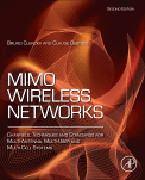
MIMO Wireless Networks: Channels, Techniques and Standards for Multi-Antenna, Multi-User and Multi-Cell Systems
Clerckx, Bruno
Oestges, Claude
This book is unique in presenting channels, techniques and standards for the next generation of MIMO wireless networks. Through a unified framework, it emphasizes how propagation mechanisms impact the system performance under realistic power constraints. Combining a solid mathematical analysis with a physical and intuitive approach to space-time signal processing, the book progressively derives innovative designs for space-time coding and precoding as well as multi-user and multi-cell techniques, taking into consideration that MIMO channels are often far from ideal. Reflecting developments since the first edition was published, this book has been thoroughly revised, and now includes new sections and five new chapters, respectively dealing with receiver design, multi-user MIMO, multi-cell MIMO, MIMO implementation in standards, and MIMO system-level evaluation. . Extended introduction to multi-dimensional propagation, including polarization aspects . Detailed and comparative description of physical models and analytical representations of single- and multi-link MIMO channels, covering the latest standardized models . Thorough overview of space-time coding techniques, covering both classical and more recent schemes under information theory and error probability perspectives . Intuitive illustration of how real-world propagation affects the capacity and the error performance of MIMO transmission schemes .Detailed information theoretic analysis of multiple access, broadcast and interference channels .In-depth presentation of multi-user diversity, resource allocation and (non-)linear MU-MIMO precoding techniques with perfect and imperfect channel knowledge . Extensive coverage of cooperative multi-cell MIMO-OFDMA networks, including network resource allocation optimization, coordinated scheduling, beamforming and power control, interference alignment, joint processing, massive and network MIMO . Applications of MIMO and Coordinated Multi-Point (CoMP) in LTE, LTE-A and WiMAX . Theoretical derivations and results contrasted with practical system level evaluations highlighting the performance of single- and multi-cell MIMO techniques in realistic deployments INDICE: Chapter 1 Introduction to multi-antenna communications Chapter 2 From Multi-Dimensional Propagation to Multi-Link MIMO Channels Chapter 3 Analytical MIMO Channel Representations For System Design Chapter 4 Physical MIMO Channel Models For Performance Simulation Chapter 5 Capacity of single-link MIMO channels Chapter 6 Space-time coding over i.i.d. Rayleigh flat fading channels Chapter 7 MIMO Receiver Design: Detection and Channel Estimation Chapter 8 Error probability in real-world MIMO channels Chapter 9 Space-time coding over real-world MIMO channels with no transmit channel knowledge Chapter 10 Space-time coding with partial transmit channel knowledge Chapter 11 Space-time coding for frequency selective channels Chapter 12 Multi-user MIMO Chapter 13 Multi-Cell MIMO Chapter 14 MIMO in LTE, LTE-Advanced and WiMAX Chapter 15 MIMO-OFDMA System Level Evaluation Appendix A Useful Mathematical and Matrix Properties Appendix B Complex Gaussian Random variables and matrices Appendix C Antenna Coupling Model Appendix D Derivation of the Average Pairwise Error Probability
- ISBN: 978-0-12-385055-3
- Editorial: Academic Press
- Encuadernacion: Cartoné
- Páginas: 776
- Fecha Publicación: 28/01/2013
- Nº Volúmenes: 1
- Idioma: Inglés
